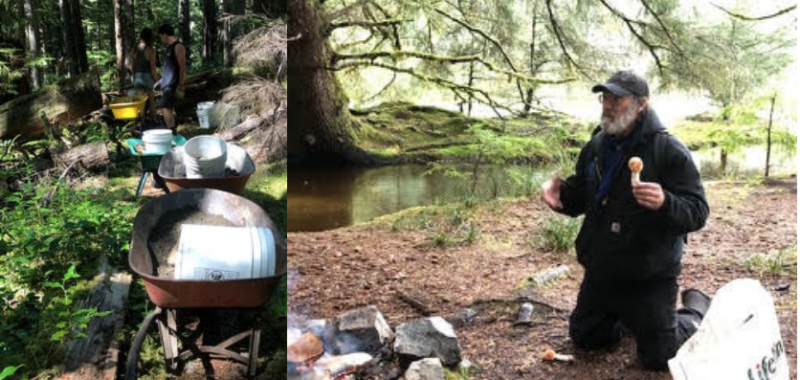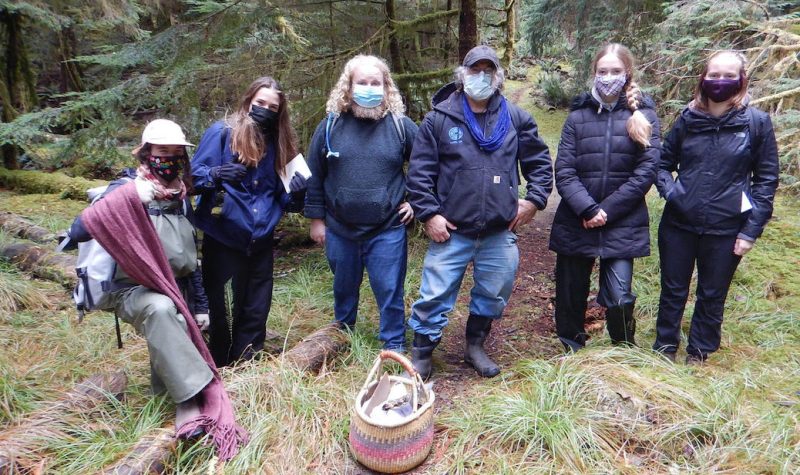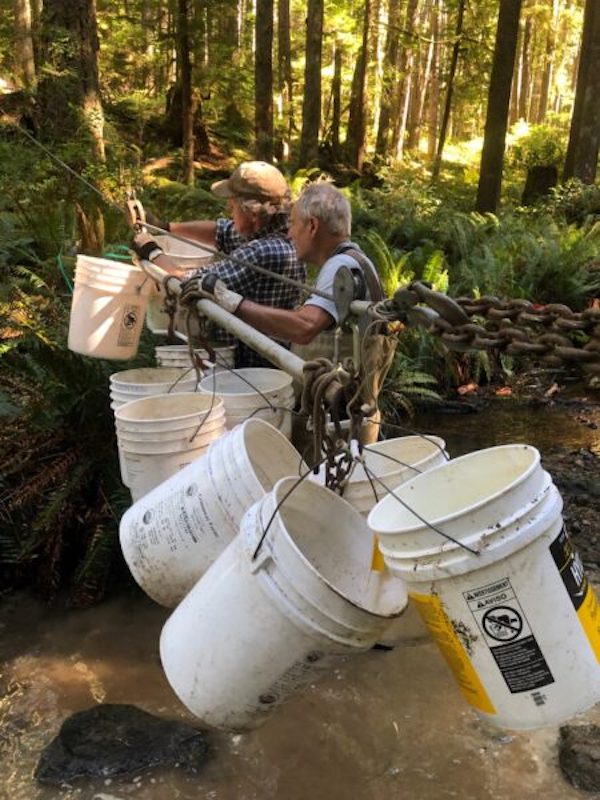By Roy L Hales
One of the advantages of virtual AGM is that people from Vancouver, Calgary, and select locations on both the West and East Coast can also attend. Most were in houses, but one was in a parked car and another on a sandy beach somewhere in Washington state. The Forest Trust for the Children of Cortes Island (FTCCIS) reviewed significant accomplishments of the past year at a ZOOM conference on Jan 23, 2021.
Mycoblitz in the Children’s Forest
“We did our first COVID compliant Mycoblitz in the Children’s Forest… We identified 66 species and added 23 new species … We build these lists over time and will clearly get into several hundred species on Cortes. I would guesstimate there are more than 2,000 species on Cortes, so this is just the very beginning, “ explained mycologist Paul Stamets, who co-led the team with Cortes Island biologist Sabina Leader-Mense.
“We took one day to focus on research and mentorship, which Sabina organized in the field with six youth. Then we had a day of education and public participation. Those youth mentored and guided us through those interpretive mycostations,” said Christine Robinson.
“We started a whole new vocabulary. I just added mycoknots to it. Mycoblitz, mycostations, mycothanks, mycomerriment, and mycowonder came out of that week-end and now I am adding mycoknots – so the vocabularly continues to expand,” added Leader-Mense.
Paul Stamets presentation
Stamets’ presentation was the main feature of the AGM and will be posted on the Forest Trust for the Children of Cortes Island website.
It was filled with illustrations like that of a woodpecker that inoculates a healthy tree with fungi. As the mycelium grows, it attracts the beetles which woodpeckers feed on.
“Parasitic fungi kill the trees, but with a few exceptions, most parasitic fungi take advantage of trees that already have a weakened immune system because of habitat stress, pollution, malnutrition or other things that have happened to it,” said Stamets.
He made the analogy of wolves cutting out the weakest elk, so that the herd was actually strengthened.
Stamets added that many of the medicinal properties attributed to plants are actually derived from the endophytic fungi inside of them.
“They are a consortia inside of a plant, or inside of a tree, that give the plant or tree a strong state of health,” he said.
According to mycologist Suzanne Simard, ’Mother trees’ communicate and send nutrients to their offspring through the mycorrhizal network.
There is much more in Stamets’ lecture: the latin names of numerous species; common mushrooms; edible mushrooms; poisonous mushrooms and their effects; a mushroom that kills trees; a fungi used for dyes; mushrooms that help clear up toxic waste; medicinal properties of numerous species; a mushroom that could help against COVID; edible mushrooms; poisonous mushrooms and their effects; mushrooms that regrow after they are picked. etc.
Focus for 2021
The AGM turned to regular business after Stamet’s presentation.
Board Chair Chris Dragseth gave an overview of the focus for 2021:
“Refreshing our strategic plan; redesigning some of our programs; partnerships; building on in situ forest events that are all COVID friendly; fund raising, again COVID friendly.”
“From a longer term perspective, I want to reemphasize the ongoing work we are doing with Mosaic, in fostering a sound relationship and exploring all options that would provide the necessary preservation and protection of the Children’s Forest. We have been meeting with them for two years and … are moving forward with a sound understanding of what our relationship looks like and are also pursuing some options that we really can’t talk about in this discussion.”
He added that this involved a win-win solution for both parties.
The Trust’s Volunteers
Dragseth ended his report with an invitation to members of the community who to help out in the Children’s Forest, have suggestions for improvement, or specific areas where they would like to participate.
Robinson repeated the invitation.
She also mentioned future ventures with the Friends of Cortes island (FOCI) and the Cortes Museum’s Wild Cortes exhibit.
The Trust’s treasurer, Andrew Smyth, added that “Volunteerism is the engine of our program. Most of our effort is educational activities for children in the forest and, of course, all of those activities are led by volunteers. It doesn’t show up in the accounts. If you looked at it slightly differently and counted up all the volunteer hours, which we do have to report on … we estimate you would see maybe 1,000 volunteer hours, typically 1,500 to 1,000 hours. If we were to treat that as a cash donation, you would see an extra $20,000 of income …”
Everyone working for the Forest Trust for the Children of Cortes Island Society is a volunteer.
There was not much to report about finances, except that the Society ended the fiscal year 2020 with a deficit of $1,200.

Another fungi identified during the Mycoblitz – courtesy Chris Dragseth
Youth Programming
Christine Robinson explained, “When the pandemic hit this Spring, our board took the opportunity to reemphasize the message that the natural world is calling us. So as we all know on Cortes and it has now been substantiated by medical research and the teaching profession, the value of mucking about in nature is really important whether you are a child or an adult.”
The FTCCIS partnered with Cortes Island Family Support and the Cortes Community Health Association to offer a series of thematic activities followed by a ZOOM chat.
Robinson continued, “I do not think any of us on the board anticipated using technology to support connections to nature, but it worked and filled a social need that many of the children were looking for.”
She shared a haiku that one of the children wrote after ‘Frog and Tadpole’ week:
- “Little frog swimming
- tail shrinks
- She grows bigger
- lays eggs and jumps out”
James Creek Gravel Project
The Children’s Forest also partnered with the Friends of Cortes island (FOCI) on the James Creek gravel project. A number of other
community organizations came into the venture, which also included working with Mosaic.
“Over the past few years we’ve had some assessment done by professional biologists and streamkeeper advisers, that there is a real lack of spawning gravel in James Creek,” said Robinson.
“Logging practises way back at the turn of the century weren’t kind to spawning areas. The gravel did get removed. These projects that we are involved in are going to help. There is no doubt about it,” said Dragseth, who worked with the DFO for 27 of his 33 years with the Federal Government, prior to retiring.
Volunteers wheelbarrowed, and then ziplined, about 250 buckets of gravel to the first of several predetermined sites on James Creek.
“This is part of the streamkeeping that we do on an annual basis and is another way that our youth are able to do some mentorship and stewardship of the Children’s Forest.”

The Children’s Forest Board
There are nine positions on the Board of the Cortes Children’s Forest Trust.
Chris Dragseth, Christine Robinson, Connie Brill and Mary Lavelle have another year in their term.
Three of the directors whose two year term is now over – Andrew Smyth, Eric Hargrave and Maya Buckner – have agreed to serve for another term.
Saskia Terporten is retiring.
“This leaves two positions open. The board wishes to leave these positions open, thereby allowing the board to look for folks that have specific skill sets we can identify at some future point,” said Dragseth.




